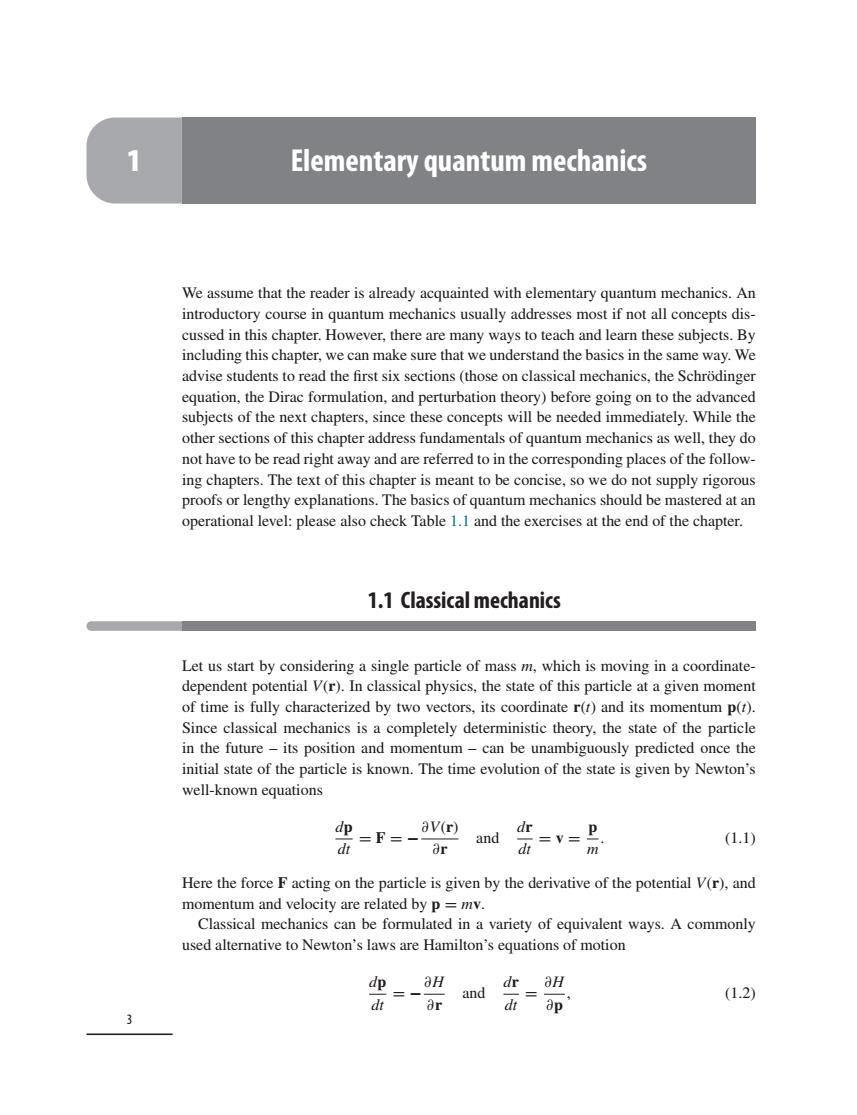正在加载图片...

Elementary quantum mechanics We assume that the reader is already acquainted with elementary quantum mechanics.An introductory course in quantum mechanics usually addresses most if not all concepts dis- cussed in this chapter.However.there are many ways to teach and learn these subiects.By including this chapter.we can make sure that we understand the basics in the same way.We advise students to read the first six sections(those on classical mechanics,the Schrodinge equation,the Dirac formulation,and perturbation theory)before going on to the advanced subjects of the next chapters,since these concepts will be needed immediately.While the other sections of this chapter address fundamentals of quantum mechanics as well,they do not have to be read right away and are referred to in the corresponding places of the follow- ing chapt ers.The te is meant to be con supply rigorou proofs or lengthy explan ons.The basics of quantum mechanics should be mastered at ar operational level:please also check Table 1.1 and the exercises at the end of the chapter. 1.1 Classical mechanics Let us start by considering a single particle of mass m,which is moving in a coordinate- dependent potential V(r).In classical physics,the state of this particle at a given moment of time is fully characterized by two ctors.its coordinate ()and its momentum p(). in the future-its position and momentum-can be unambiguously predicted once the initial state of the particle is known.The time evolution of the state is given by Newton's well-known equations 1.1) ar Here the force F acting on the particle is given by the derivative of the potential V(r),and momentum and velocity are related by p=mv. Classical mechanics can be formulated in a variety of equivalent ways.A commonly used alternative to Newton's laws are Hamilton's equations of motion (1.2) 3 1 Elementary quantum mechanics We assume that the reader is already acquainted with elementary quantum mechanics. An introductory course in quantum mechanics usually addresses most if not all concepts discussed in this chapter. However, there are many ways to teach and learn these subjects. By including this chapter, we can make sure that we understand the basics in the same way. We advise students to read the first six sections (those on classical mechanics, the Schrödinger equation, the Dirac formulation, and perturbation theory) before going on to the advanced subjects of the next chapters, since these concepts will be needed immediately. While the other sections of this chapter address fundamentals of quantum mechanics as well, they do not have to be read right away and are referred to in the corresponding places of the following chapters. The text of this chapter is meant to be concise, so we do not supply rigorous proofs or lengthy explanations. The basics of quantum mechanics should be mastered at an operational level: please also check Table 1.1 and the exercises at the end of the chapter. 1.1 Classical mechanics Let us start by considering a single particle of mass m, which is moving in a coordinatedependent potential V(r). In classical physics, the state of this particle at a given moment of time is fully characterized by two vectors, its coordinate r(t) and its momentum p(t). Since classical mechanics is a completely deterministic theory, the state of the particle in the future – its position and momentum – can be unambiguously predicted once the initial state of the particle is known. The time evolution of the state is given by Newton’s well-known equations dp dt = F = −∂V(r) ∂r and dr dt = v = p m. (1.1) Here the force F acting on the particle is given by the derivative of the potential V(r), and momentum and velocity are related by p = mv. Classical mechanics can be formulated in a variety of equivalent ways. A commonly used alternative to Newton’s laws are Hamilton’s equations of motion dp dt = −∂H ∂r and dr dt = ∂H ∂p , (1.2) 3